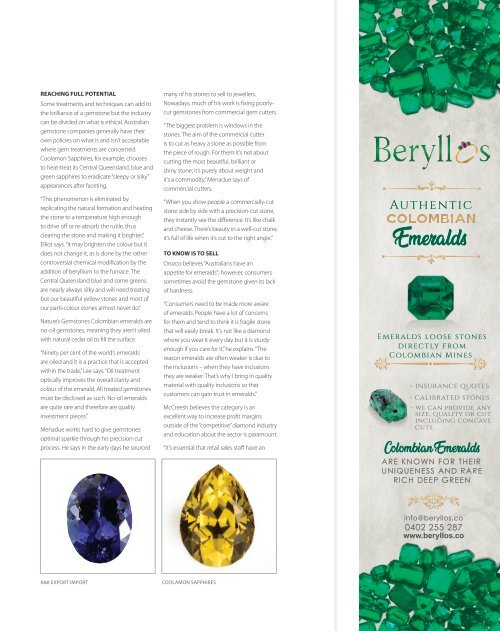Jeweller - November 2018
Create successful ePaper yourself
Turn your PDF publications into a flip-book with our unique Google optimized e-Paper software.
REACHING FULL POTENTIAL<br />
Some treatments and techniques can add to<br />
the brilliance of a gemstone but the industry<br />
can be divided on what is ethical. Australian<br />
gemstone companies generally have their<br />
own policies on what is and isn’t acceptable<br />
where gem treatments are concerned.<br />
Coolamon Sapphires, for example, chooses<br />
to heat-treat its Central Queensland, blue and<br />
green sapphires to eradicate “sleepy or silky”<br />
appearances after faceting.<br />
“This phenomenon is eliminated by<br />
replicating the natural formation and heating<br />
the stone to a temperature high enough<br />
to drive off or re-absorb the rutile, thus<br />
clearing the stone and making it brighter,”<br />
Elliot says. “It may brighten the colour but it<br />
does not change it, as is done by the rather<br />
controversial chemical modification by the<br />
addition of beryllium to the furnace. The<br />
Central Queensland blue and some greens<br />
are nearly always silky and will need treating<br />
but our beautiful yellow stones and most of<br />
our parti-colour stones almost never do.”<br />
Nature’s Gemstones Colombian emeralds are<br />
no-oil gemstones, meaning they aren’t oiled<br />
with natural cedar oil to fill the surface.<br />
“Ninety per cent of the world’s emeralds<br />
are oiled and it is a practice that is accepted<br />
within the trade,” Lee says. “Oil treatment<br />
optically improves the overall clarity and<br />
colour of the emerald. All treated gemstones<br />
must be disclosed as such. No-oil emeralds<br />
are quite rare and therefore are quality<br />
investment pieces.”<br />
Menadue works hard to give gemstones<br />
optimal sparkle through his precision-cut<br />
process. He says in the early days he sourced<br />
many of his stones to sell to jewellers.<br />
Nowadays, much of his work is fixing poorlycut<br />
gemstones from commercial gem cutters.<br />
“The biggest problem is windows in the<br />
stones. The aim of the commercial cutter<br />
is to cut as heavy a stone as possible from<br />
the piece of rough. For them it’s not about<br />
cutting the most beautiful, brilliant or<br />
shiny stone; it’s purely about weight and<br />
it’s a commodity,” Menadue says of<br />
commercial cutters.<br />
“When you show people a commercially-cut<br />
stone side by side with a precision-cut stone,<br />
they instantly see the difference. It’s like chalk<br />
and cheese. There’s beauty in a well-cut stone;<br />
it’s full of life when it’s cut to the right angle.”<br />
TO KNOW IS TO SELL<br />
Orozco believes “Australians have an<br />
appetite for emeralds”; however, consumers<br />
sometimes avoid the gemstone given its lack<br />
of hardness.<br />
“Consumers need to be made more aware<br />
of emeralds. People have a lot of concerns<br />
for them and tend to think it is fragile stone<br />
that will easily break. It’s not like a diamond<br />
where you wear it every day but it is sturdy<br />
enough if you care for it,” he explains. “The<br />
reason emeralds are often weaker is due to<br />
the inclusions – when they have inclusions<br />
they are weaker. That’s why I bring in quality<br />
material with quality inclusions so that<br />
customers can gain trust in emeralds.”<br />
McCreesh believes the category is an<br />
excellent way to increase profit margins<br />
outside of the “competitive” diamond industry<br />
and education about the sector is paramount.<br />
“It’s essential that retail sales staff have an<br />
K&K EXPORT IMPORT<br />
COOLAMON SAPPHIRES


















